Death Valley is located in Eastern California, USA, and is the largest national park in the lower 48 states, covering over 3.4 million acres of land. It is known for its extreme temperatures, stunning natural landscapes, and unique geological features.
From someone who has visited this park numerous of times here is a complete guide to build your itinerary no matter how many days you are visiting.
Fun Facts about Death Valley
- Death Valley is the hottest and driest place in North America, with temperatures reaching up to 134 degrees Fahrenheit (56.7 degrees Celsius) and an average annual rainfall of only 2 inches (5 cm).
- The park is home to the lowest point in North America, Badwater Basin, which is 282 feet (86 meters) below sea level.
- Death Valley also boasts the highest point in the park, Telescope Peak, which stands at 11,049 feet (3,368 meters) tall.
- The park’s unique geological formations include Mesquite Flat Sand Dunes, which are the largest dunes in the park and can reach up to 100 feet (30 meters) tall.
- Death Valley is home to a variety of unique wildlife, including bighorn sheep, desert tortoises, coyotes, and roadrunners.
- The park has been the backdrop for many movies, including Star Wars, Indiana Jones and the Last Crusade, and Jurassic Park.
- Despite its name, Death Valley is home to many thriving plant and animal species, including several species of cacti and wildflowers that bloom in the spring.
- The park has a rich history, with evidence of human habitation dating back over 10,000 years. The area was also home to borax mining operations in the late 1800s and early 1900s, which were important for the development of modern industry.
Use this Guide to help build your own Itinerary
Best Time of Year To Visit Death Valley
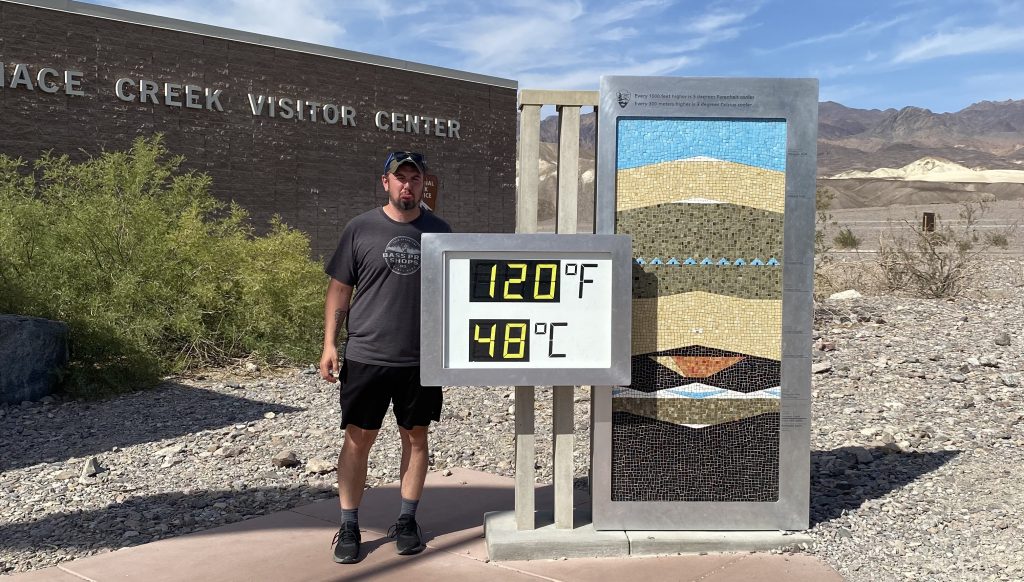
The best time of year to visit Death Valley National Park depends on your preferences and what you want to do in the park. Here’s a breakdown of the different seasons and what you can expect:
- Winter (December – February): Winter is the peak tourist season in Death Valley, and for good reason. The weather is mild and comfortable, with daytime temperatures ranging from the mid-60s to low 70s Fahrenheit (18-22°C). It’s also the best time to see wildflowers in bloom and to explore the park’s hiking trails.
- Spring (March – May): Spring is another popular time to visit Death Valley, especially for those who want to see the park’s stunning wildflower displays. Temperatures can be quite warm, with daytime highs ranging from the 70s to low 90s Fahrenheit (21-32°C).
- Summer (June – August): Summer is the hottest time of year in Death Valley, with daytime temperatures often exceeding 100°F (38°C) and sometimes reaching as high as 120°F (49°C). However, it’s also the best time to explore the park’s higher elevations, such as the Panamint Mountains and the Telescope Range, where temperatures are cooler.
- Fall (September – November): Fall is a great time to visit Death Valley if you’re looking for cooler temperatures and fewer crowds. Daytime highs range from the 70s to low 90s Fahrenheit (21-32°C), and the park’s hiking trails are still open for exploration.
Keep in mind that temperatures can be extreme at any time of year, so be sure to come prepared with plenty of water and sunscreen, regardless of when you visit.
Park Passes
There are several places where visitors can purchase park passes or day passes in Death Valley National Park.
Side Note: You will need to provide park passes to receive a map of the park at the visitor center.
- Furnace Creek Visitor Center: This is the main visitor center in the park and is located near the center of Death Valley. Visitors can purchase park passes, day passes, and other permits here.
- Stovepipe Wells Ranger Station: This ranger station is located on the west side of Death Valley and offers park passes and day passes.
- Entrance Stations: There are several entrance stations located throughout the park where visitors can purchase day passes. These include the West Entrance Station, the North Entrance Station, and the South Entrance Station.
- Online: Visitors can also purchase park passes and day passes online through the National Park Service website.
It’s important to note that park passes are valid for seven consecutive days from the date of purchase and are required for all visitors entering the park. Day passes are valid for a single day and can be purchased for individual or multiple passengers in a single vehicle. Be sure to check the National Park Service website for current pricing and any changes to park policies.
While planning your trip to Death Valley note that there are lodging and camping options inside the park.
Lodging in Death Valley
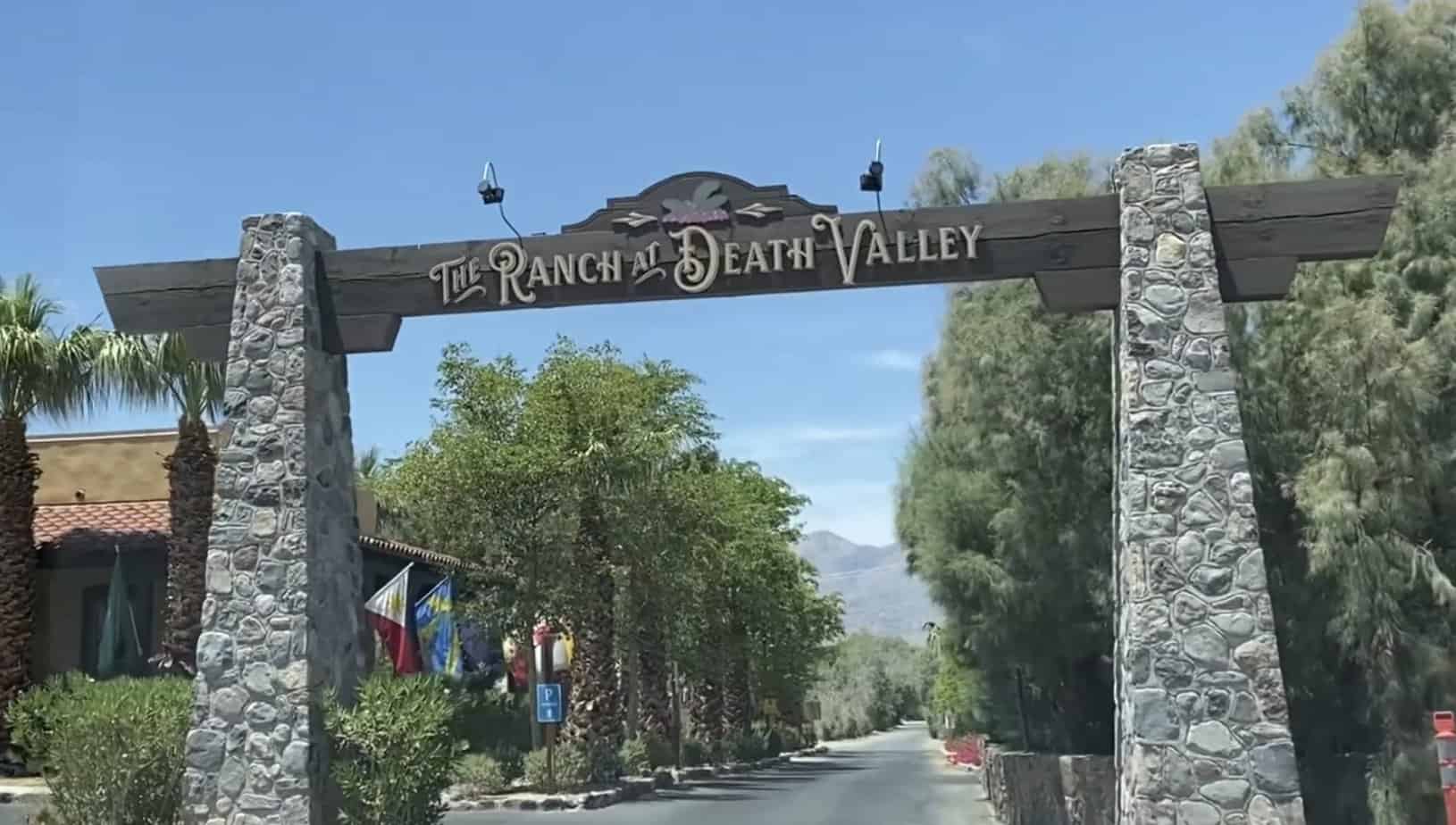
- The Inn at Death Valley – Book Here on Expedia
- The Ranch at Death Valley – Book Here on Expedia
- Stovepipe Wells Village Hotel – Book Here on Expedia
- Panamint Spring Resort – Book Here on Expedia
Other lodging with stores and restaurants can be found in the city of Pahrump, NV. Pahrump is 59 miles from Death Valley.
Camping
RV Sites
- Furnace Creek Campground – More Details
- Texas Springs Campground – More Details
- Sunset Campground – More Details
- Stovepipe Wells Campground – More Details
- Emigrant Campground – More Details
- Wildrose Campground – More Details
- Mesquite Spring campground – More Details
Primitive Sites
- Eureka Dunes Campground – More Details
- Homestake Campground – More Details
- Saline Valley Campground – More Details
- Mahogany Flat Campground – More Details
- Thorndike Campground – More Details
Primitive Campgrounds have zero cell service, water, firewood. All primitive sites are First Come First Serve and a $0.00 Fee.
Restaurants And Stores in Death Valley
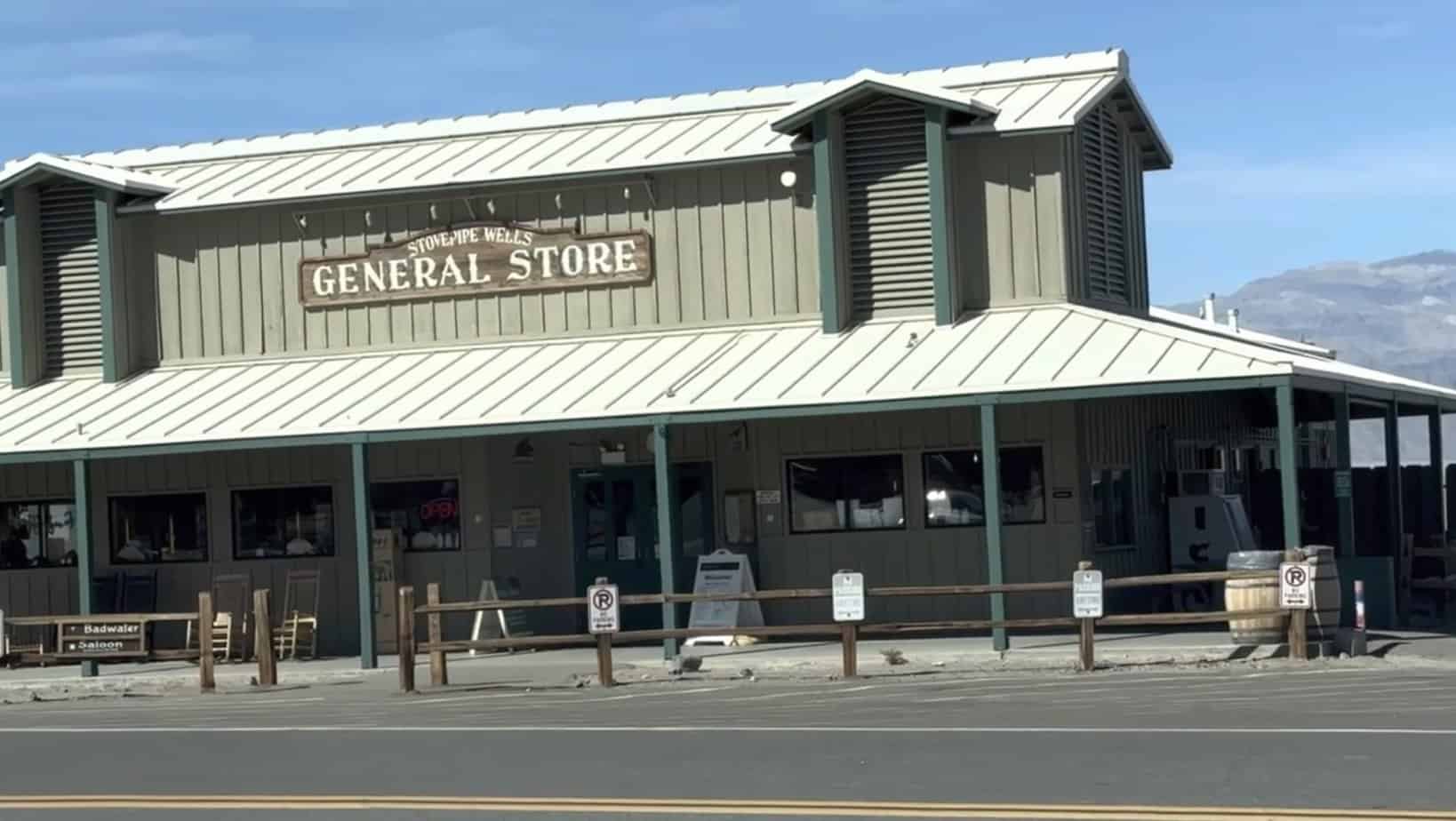
Furnace Creek
The Oasis at Death Valley
- The Inn Dining Room
- The Ranch 1849 Buffet
- The Last Kind Words Saloon
- Coffee and Cream
- General Store
- Golf Pro Shop
Timbisha Shoshone Village – Currently Closed
- Indian Tacos and Shaved Ice
- Furnace Creek Visitor Center/Death Valley Natural History Association Bookstore
Stovepipe Wells
- Toll Road Restaurant
- Badwater Saloon
- General Store – Cheapest Convenience Items (sodas and snacks)
Panamint Springs
- Dining & Bar
- General Store
Gas Stations in Death Valley

Stovepipe Wells Gas Station – $ Cheapest $
Address: 51880 CA-190, Death Valley, CA 92328
Regular Unleaded Only. They do not offer premium, plus, or diesel.
Furnace Creek Gas Station – $$$ Most Expensive $$$
Address: CA-190, Death Valley, CA 92328
Furnace Creek has unleaded, plus, premium, and diesel.
Panamint Springs Gas Station
Address: 40440 CA-190, Darwin, CA 93522
Gas offered here is regular, midgrade, premium, and diesel.
Day Hikes Under 5 Miles You Don’t Want To Miss
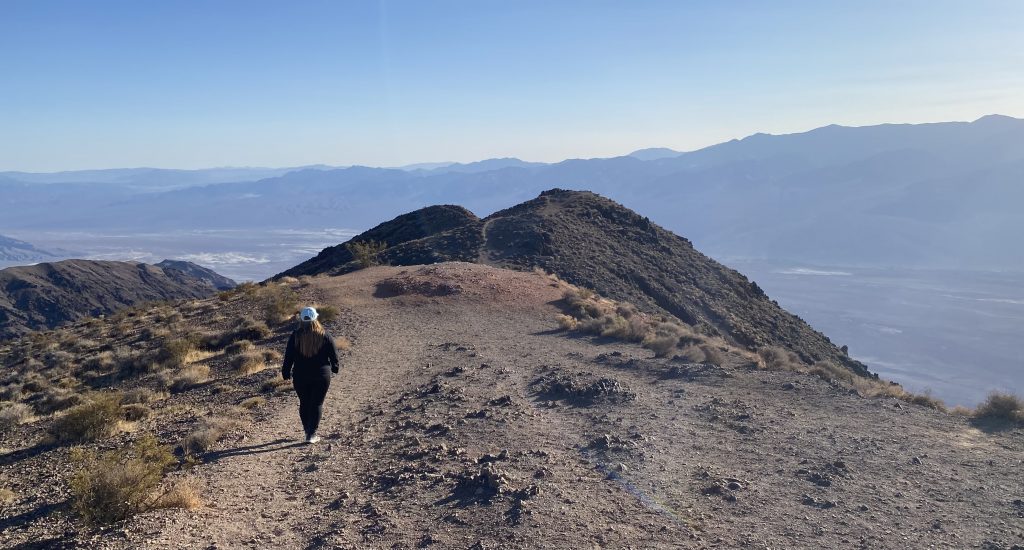
- Badwater Salt Flat: This hike is an easy, flat walk across the salt flats that lie 282 feet below sea level, making it the lowest point in North America. The trailhead is located at the Badwater Basin parking area.
- Natural Bridge Canyon: This hike is a 1-mile round trip and takes you through a narrow canyon that ends at a natural bridge. The trailhead is located on Badwater Road.
- Harmony Borax Works: This hike is an easy, 0.4-mile round trip and takes you through the ruins of an old borax mining operation. The trailhead is located on Furnace Creek Road.
- Golden Canyon: This hike is a 2.5-mile round trip and takes you through a scenic canyon with towering rock formations. The trailhead is located on Badwater Road.
- Mesquite Flat Sand Dunes: This hike is an easy walk through the sand dunes and offers stunning views of the surrounding mountains. The trailhead is located on Mesquite Flat Road.
- Mosaic Canyon: This hike is a 4-mile round trip and takes you through a narrow canyon with polished marble walls. The trailhead is located on Stovepipe Wells Road.
- Salt Creek Interpretive Trail: This hike is an easy, 0.5-mile round trip and takes you through a salt marsh where you can see rare pupfish. To View pupfish visit during winter and spring months.
- Zabriskie Point: This hike is a short paved walk up to a viewpoint that offers stunning views of the badlands and golden hills. The trailhead is located on Highway 190.
- Darwin Falls: This hike is a 2-mile round trip and takes you to a waterfall in a lush oasis in the middle of the desert. The trailhead is located on Panamint Valley Road.
- Ubehebe Crater: This hike is an easy walk around a massive volcanic crater that is 600 feet deep and half a mile wide. The trailhead is located on Scotty’s Castle Road.
Scenic Driving Routes in Death Valley
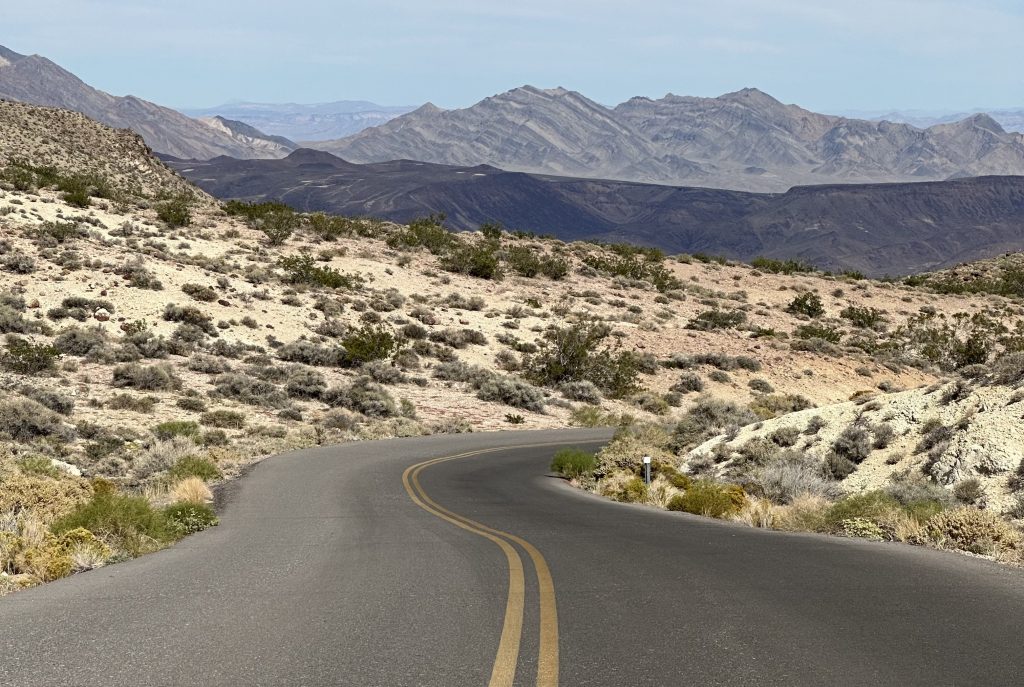
If hiking isn’t your thing there are several scenic driving routes in Death Valley that offer breathtaking views of the desert landscape. Here are some of the most popular ones:
- Artist’s Drive: This 9-mile scenic drive takes you through a narrow canyon with multicolored rock formations. It’s particularly stunning during sunrise and sunset.
- Badwater Road: This 17-mile road takes you through some of the most iconic locations in Death Valley, including the Badwater Basin, Devil’s Golf Course, and Natural Bridge Canyon.
- Dante’s View: This drive takes you up a winding road to a viewpoint that offers panoramic views of Death Valley from over 5,000 feet above sea level.
- Mesquite Flat Road: This 20-mile road takes you through the heart of the Mesquite Flat Sand Dunes and offers stunning views of the surrounding mountains.
- Scotty’s Castle Road: This 50-mile road takes you to Scotty’s Castle, a historic mansion built in the 1920s, as well as several other historic sites and viewpoints.
- Titus Canyon Road: This one-way, 27-mile road takes you through a narrow canyon with towering walls of rock, as well as several abandoned mining towns and ghost towns.
- Wildrose Road: This 23-mile road takes you to the Wildrose Charcoal Kilns, historic structures that were used to produce charcoal for mining operations in the late 1800s.
These trails all provide breathtaking views of Death Valley’s distinctive and unearthly scenery. Before starting any drive, make sure to check the weather and the state of the roads. Furthermore, bring plenty of water and supplies, as services might not be available.
Death Valley National Park is a truly unique and awe-inspiring destination that offers a glimpse into the harsh yet beautiful landscape of the American Southwest. Whether you’re interested in hiking, scenic drives, or simply taking in the stunning vistas, there is something for everyone to enjoy in Death Valley.
In addition to packing lots of water, food, and sunscreen, keep in mind that exploring this rocky terrain can be dangerous due to the high temperatures and other potential risks. A visit to Death Valley might be a once-in-a-lifetime event that you won’t forget.
Consider Donating To Death Valley and other National Parks: https://www.nps.gov/deva/getinvolved/donate.htm
